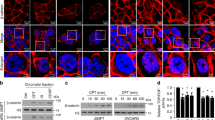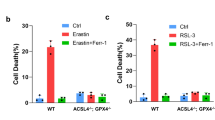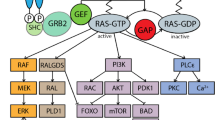Abstract
Arsenite trioxide (As2O3) induces apoptosis in several cell lines by disturbing key signal transduction pathways through its oxidative properties. Here, we report that As2O3 also induces the phosphorylation of the retinoid receptor RXRα, subsequent to oxidative damages and the activation of the stress-activated protein kinases cascade (JNKs). We also report that RA amplifies both As2O3-induced phosphorylation of RXRα and apoptosis. Taking advantage of ‘rescue’ F9 cell lines expressing RXRα mutated at its phosphorylation sites, in an RXRα null background, we provide evidence that RXRα is a key element involved in that potentiating effect. Finally, we demonstrate that As2O3 also abrogates the transactivation of RA-target genes.
This is a preview of subscription content, access via your institution
Access options
Subscribe to this journal
Receive 50 print issues and online access
$259.00 per year
only $5.18 per issue
Buy this article
- Purchase on Springer Link
- Instant access to full article PDF
Prices may be subject to local taxes which are calculated during checkout










Similar content being viewed by others
References
Adam-Stitah S, Penna L, Chambon P and Rochette-Egly C . (1999). J. Biol. Chem., 274, 18932–18941.
Altucci L and Gronemeyer H . (2001a). Trends Endocrinol. Metab., 12, 460–468.
Altucci L and Gronemeyer H . (2001b). Nat. Rev. Cancer, 1, 181–193.
Bastien J, Adam-Stitah S, Plassat JL, Chambon P and Rochette-Egly C . (2002). J. Biol. Chem., 24, 24.
Bastien J, Adam-Stitah S, Riedl T, Egly JM, Chambon P and Rochette-Egly C . (2000). J. Biol. Chem., 275, 21896–21904.
Bastien J and Rochette-Egly C . (2004). Gene, 328, 1–16.
Bebien M, Salinas S, Becamel C, Richard V, Linares L and Hipskind RA . (2003). Oncogene, 22, 1836–1847.
Bennett BL, Sasaki DT, Murray BW, O'Leary EC, Sakata ST, Xu W, Leisten JC, Motiwala A, Pierce S, Satoh Y, Bhagwat SS, Manning AM and Anderson DW . (2001). Proc. Natl. Acad. Sci. USA, 98, 13681–13686.
Benoit G, Altucci L, Flexor M, Ruchaud S, Lillehaug J, Raffelsberger W, Gronemeyer H and Lanotte M . (1999). EMBO J., 18, 7011–7018.
Bernstam L and Nriagu J . (2000). J. Toxicol. Environ. Health B. Crit. Rev., 3, 293–322.
Boudjelal M, Voorhees JJ and Fisher GJ . (2002). Exp. Cell Res., 274, 130–137.
Buchwalter G, Gross C and Wasylyk B . (2004). Gene, 324, 1–14.
Caelles C, Gonzalez-Sancho JM and Munoz A . (1997). Genes Dev., 11, 3351–3364.
Cavigelli M, Li WW, Lin A, Su B, Yoshioka K and Karin M . (1996). EMBO J., 15, 6269–6279.
Chambon P . (1996). FASEB J., 10, 940–954.
Clifford J, Chiba H, Sobieszczuk D, Metzger D and Chambon P . (1996). EMBO J., 15, 4142–4155.
de The H, Chomienne C, Lanotte M, Degos L and Dejean A . (1990). Nature, 347, 558–561.
Gaub MP, Rochette-Egly C, Lutz Y, Ali S, Matthes H, Scheuer I and Chambon P . (1992). Exp. Cell Res., 201, 335–346.
Ghosh R and Mitchell DL . (1999). Nucleic Acids Res., 27, 3213–3218.
Gianni M, Bauer A, Garattini E, Chambon P and Rochette-Egly C . (2002a). EMBO J., 21, 3760–3769.
Gianni M, Koken MH, Chelbi-Alix MK, Benoit G, Lanotte M, Chen Z and de The H . (1998). Blood., 91, 4300–4310.
Gianni M, Kopf E, Bastien J, Oulad-Abdelghani M, Garattini E, Chambon P and Rochette-Egly C . (2002b). J. Biol. Chem., 277, 24859–24862.
Gianni M, Tarrade A, Nigro EA, Garattini E and Rochette-Egly C . (2003). J. Biol. Chem., 5, 389–401.
Hayakawa F and Privalsky ML . (2004). Cancer Cell, 5, 389–401.
He Z, Ma WY, Liu G, Zhang Y, Bode AM and Dong Z . (2003). J. Biol. Chem., 278, 10588–10593.
Hong SH, Yang Z and Privalsky ML . (2001). Mol. Cell. Biol., 21, 7172–7182.
Huang C, Ke Q, Costa M and Shi X . (2004). Mol. Cell. Biochem., 255, 57–66.
Iordanov MS and Magun BE . (1999). J. Biol. Chem., 274, 25801–25806.
Kapahi P, Takahashi T, Natoli G, Adams SR, Chen Y, Tsien RY and Karin M . (2000). J. Biol. Chem., 275, 36062–36066.
Keriel A, Stary A, Sarasin A, Rochette-Egly C and Egly JM . (2002). Cell, 109, 125–135.
Kessel M, Liu SX, Xu A, Santella R and Hei TK . (2002). Mol. Cell. Biochem., 234–235, 301–308.
Kitchin KT and Ahmad S . (2003). Toxicol. Lett., 137, 3–13.
Lallemand-Breitenbach V, Zhu J, Puvion F, Koken M, Honore N, Doubeikovsky A, Duprez E, Pandolfi PP, Puvion E, Freemont P and de The H . (2001). J. Exp. Med., 193, 1361–1371.
Laudet V and Gronemeyer H . (2001). Nuclear Receptor Factsbook. Academic Press: London.
Lee HY, Sueoka N, Hong WK, Mangelsdorf DJ, Claret FX and Kurie JM . (1999). Mol. Cell. Biol., 19, 1973–1980.
Lee HY, Suh YA, Robinson MJ, Clifford JL, Hong WK, Woodgett JR, Cobb MH, Mangelsdorf DJ and Kurie JM . (2000). J. Biol. Chem., 275, 32193–32199.
Lerner L, Henriksen MA, Zhang X and Darnell Jr JE . (2003). Genes Dev., 17, 2564–2577.
Li J, Chen P, Sinogeeva N, Gorospe M, Wersto RP, Chrest FJ, Barnes J and Liu Y . (2002). J. Biol. Chem., 277, 49504–49510.
Li J, Gorospe M, Barnes J and Liu Y . (2003a). J. Biol. Chem., 278, 13183–13191.
Li QJ, Yang SH, Maeda Y, Sladek FM, Sharrocks AD and Martins-Green M . (2003b). EMBO J., 22, 281–291.
Lim CP, Jain N and Cao X . (1998). Oncogene, 16, 2915–2926.
Liu Q, Hilsenbeck S and Gazitt Y . (2003). Blood, 101, 4078–4087.
Meriin AB, Yaglom JA, Gabai VL, Zon L, Ganiatsas S, Mosser DD and Sherman MY . (1999). Mol. Cell. Biol., 19, 2547–2555.
Mologni L, Ponzanelli I, Bresciani F, Sardiello G, Bergamaschi D, Gianni M, Reichert U, Rambaldi A, Terao M and Garattini E . (1999). Blood, 93, 1045–1061.
Na SY, Choi HS, Kim JW, Na DS and Lee JW . (1998). J. Biol. Chem., 273, 30933–30938.
Nesnow S, Roop BC, Lambert G, Kadiiska M, Mason RP, Cullen WR and Mass MJ . (2002). Chem. Res. Toxicol., 15, 1627–1634.
Oridate N, Esumi N, Lotan D, Hing WK, Rochette-Egly C, Chambon P and Lotan R . (1996). Oncogene, 12, 2019–2028.
Puccetti E, Beissert T, Guller S, Li JE, Hoelzer D, Ottmann OG and Ruthardt M . (2003). Oncogene, 22, 6900–6908.
Rego EM, He LZ, Warrell Jr RP, Wang ZG and Pandolfi PP . (2000). Proc Natl Acad Sci USA, 97, 10173–10178.
Rochette-Egly C and Chambon P . (2001). Histol. Histopathol., 16, 909–922.
Rochette-Egly C . (2003). Cell. Signal., 15, 355–366.
Rochette-Egly C, Adam S, Rossignol M, Egly JM and Chambon P . (1997). Cell, 90, 97–107.
Rochette-Egly C, Lutz Y, Pfister V, Heyberger S, Scheuer I, Chambon P and Gaub MP . (1994). Biochem. Biophys. Res. Commun., 204, 525–536.
Roussel MJ and Lanotte M . (2001). Oncogene, 20, 7287–7291.
Sakaue M, Adachi H, Dawson M and Jetten AM . (2001). Cell Death Differ., 8, 411–424.
Schwerdtle T, Walter I, Mackiw I and Hartwig A . (2003). Carcinogenesis, 24, 967–974.
Shen ZX, Shi ZZ, Fang J, Gu BW, Li JM, Zhu YM, Shi JY, Zheng PZ, Yan H, Liu YF, Chen Y, Shen Y, Wu W, Tang W, Waxman S, De The H, Wang ZY, Chen SJ and Chen Z . (2004). Proc. Natl. Acad. Sci. USA, 101, 5328–5335.
Shi H, Shi X and Liu KJ . (2004). Mol. Cell. Biochem., 255, 67–78.
Taneja R, Rochette-Egly C, Plassat JL, Penna L, Gaub MP and Chambon P . (1997). EMBO J., 16, 6452–6465.
Theodosiou A and Ashworth A . (2002). Oncogene, 21, 2387–2397.
Verma A, Mohindru M, Deb DK, Sassano A, Kambhampati S, Ravandi F, Minucci S, Kalvakolanu DV and Platanias LC . (2002). J. Biol. Chem., 277, 44988–44995.
Xi H and Kersh GJ . (2003). J. Immunol., 170, 315–324.
Zhang TD, Chen GQ, Wang ZG, Wang ZY, Chen SJ and Chen Z . (2001). Oncogene, 20, 7146–7153.
Zhu J, Chen Z, Lallemand-Breitenbach V and de The H . (2002a). Nat. Rev. Cancer, 2, 705–713.
Zhu J, Gianni M, Kopf E, Honore N, Chelbi-Alix M, Koken M, Quignon F, Rochette-Egly C and de Thé H . (1999). Proc. Natl. Acad. Sci. USA, 96, 14807–14812.
Zhu J, Lallemand-Breitenbach V and de The H . (2001). Oncogene, 20, 7257–7265.
Zhu Q, Zhang JW, Zhu HQ, Shen YL, Flexor M, Jia PM, Yu Y, Cai X, Waxman S, Lanotte M, Chen SJ, Chen Z and Tong JH . (2002b). Blood, 99, 1014–1022.
Acknowledgements
We thank S Adam-Stitah, J Clifford, D Metzger and P Chambon for providing mutant F9 cell lines. We are grateful to Dr Theodosiou for the generous gift of the M3/M6 expression vector. We are grateful to Gaetan Bour for critically reading the manuscript. We thank JL Plassat for helpful advice on quantitative RT–PCR. We also thank members of the cell culture and oligonucleotides facilities for help. This work was supported by funds from the Centre National de la Recherche scientifique (CNRS), the Institut National de la Recherche Médicale (INSERM), the Hôpital Universitaire de Strasbourg, the Association pour la Recherche sur le Cancer and Bristol-Myers Squibb. Anne Tarrade was supported by the ‘Ligue Nationale contre le Cancer’. JB was supported by the Ministère de la Recherche et de l'Enseignement Supérieur, by the ‘Ligue Nationale contre le Cancer’ and by the ‘Fondation pour la Recherche Médicale’.
Author information
Authors and Affiliations
Corresponding author
Rights and permissions
About this article
Cite this article
Tarrade, A., Bastien, J., Bruck, N. et al. Retinoic acid and arsenic trioxide cooperate for apoptosis through phosphorylated RXR alpha. Oncogene 24, 2277–2288 (2005). https://doi.org/10.1038/sj.onc.1208402
Received:
Revised:
Accepted:
Published:
Issue Date:
DOI: https://doi.org/10.1038/sj.onc.1208402
Keywords
This article is cited by
-
Overview of the structure-based non-genomic effects of the nuclear receptor RXRα
Cellular & Molecular Biology Letters (2018)
-
Identifying a panel of genes/proteins/miRNAs modulated by arsenicals in bladder, prostate, kidney cancers
Scientific Reports (2018)



